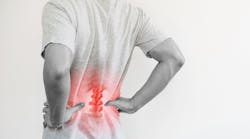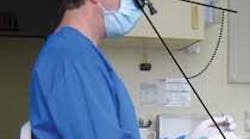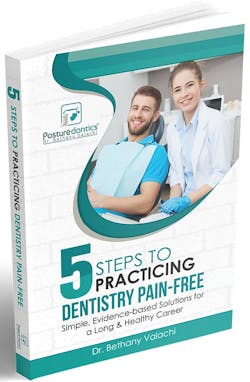Trapezius myalgia: Making dentistry a pain in the neck—or head
By midmorning, it starts ... again; the all-too-familiar "tension headache" that soon evolves into a headache behind the dentist's right eye and pain in his right temple. In an adjacent operatory, the hygienist experiences burning pain on the left side of her neck. Why does this happen? Both clinicians recently embarked upon diligent exercise programs with their personal trainers in an effort to improve their musculoskeletal health and avoid such painful episodes.
Does this sound familiar? If so, you're in good company—the incidence of neck pain among dentists and hygienists has been reported as high as 71% and 82% respectively. The causes of headaches and neck pain are multifactorial; however, in dentistry, the upper trapezius muscle is the culprit in a myriad of head and neck pain syndromes.
The delivery of dental care places high demands on this muscle and can result in a painful condition called trapezius myalgia. Symptoms include pain, spasms, or tenderness in the upper trapezius muscle, often on the side of the mirror, or retracting arm (figure 1). Trigger points in this muscle result in headaches behind the eye, into the temple, and in back of the neck.
The upper trapezius muscles are responsible for elevating the shoulders and rotating the neck. In rounded shoulder posture, the upper trapezius and neck muscles largely support the arm's weight, increasing muscular strain on the neck and shoulder. In dentistry, trapezius myalgia is caused by static, prolonged elevation of the shoulders, mental stress, infrequent breaks, and poor head posture.
Interventions
Don't position the patient too high. The operator assumes one of two postures—working with the shoulders elevated (which leads to trapezius myalgia), or shoulder abduction (which leads to rotator cuff impingement). Additionally, working with the shoulders on a tilted axis or with the head turned to one side or tilted forward can lead to worsening symptoms in these muscles. Position the patient so the oral cavity is at elbow level or 4 cm above elbow level. When the patient is higher than this, arm abduction or shoulder elevation typically occurs, especially when working between the 8 o'clock and 11 o'clock positions. Operators with short torsos or long upper arms find that when they position their knees under the patient head or backrest, the combined thickness of the patient chair and patient's head causes them to elevate their shoulders. This problem is best resolved with a saddle stool, which allows lower patient positioning and improves proximity by opening the operator's hip angle.
Use properly selected magnification. Poor head posture is commonly observed in the operatory and strains the upper trapezius muscles. Microscopes and procedures lead to better head postures, while properly selected telescopes can enable head postures of 20 degrees or less. Scopes with poor declination angles, improperly measured working distance, and/or a small frame size can actually cause or worsen trapezius myalgia.
Utilize armrests. Supporting the arm weight is especially important for trapezius myalgia sufferers. Clinicians should make sure their armrest height is adjusted properly. Adjusting the armrests too high can cause neck stiffness and pain at the crook of the neck and shoulder. If you find it difficult to maneuver a chair with armrests around the patient, you may want a unilateral armrest fixed to a counter (figure 2). Dentists who operate with their left arm supported have been shown to have less pain than those who do not. These devices are available in a variety of heights and are especially useful since more dentists and hygienists experience pain in the left shoulder than in the right.
Frequent breaks/chairside stretching. One EMG study of the neck, shoulders, and arms showed that the highest muscular activity during dental work occurs in the trapezius muscles. Sustained low-level contraction of these muscles with few breaks greatly increases susceptibility to pain. With insufficient rest periods or dynamic movement (i.e., chairside stretching), tension can accumulate in these muscles, and by the end of the day you may be wearing your shoulders as "earrings" without realizing it.
Stress management. Common clichés such as "pain in the neck" allude to stress as a cause of pain. This association is actually quite true. High levels of emotional stress and working at complex tasks can elicit muscular contraction in the upper trapezius muscle. This subconscious muscular contraction in response to stress is called neuromuscular hypertension. If the stress response is not followed by dynamic muscular activity, the blood pressure has no outlet and continues to rise. The statically contracted muscle becomes ischemic and painful while the blood pressure remains high. Therefore, stress management strategies that specifically target muscular-type pain are helpful in prevention. One that is particularly effective is progressive relaxation, which allows one to identify and quickly relax tense muscles.
Proper exercise. Training the upper trapezius muscle with heavy weight resistance is one of the most common exercise mistakes dental professionals make. This can worsen the unique muscle imbalance to which they are already prone, create trigger points, and worsen neck pain. Rather, dental professionals should target the upper trapezius muscles with aerobic exercises such as walking while swinging the arms, rowing, and cross country skiing.
Women's issues. Narrow bra straps can compress the upper trapezius muscles, worsen neck pain, and create headaches, especially among female dental professionals with large chests. Racer-back sports bras have wider straps and are a better choice. A purse slung over one shoulder can also perpetuate muscle imbalances to which female dental professionals are prone, since the trapezius muscle must contract unilaterally to support the weight.
Heat is usually the best choice for the chronic pain, stiffness and dull aches that are characteristic of muscular-type pain. Be sure to consult a health-care professional for proper application and use of heat.
Massage is a very beneficial therapy and effective in the management and prevention of trapezius myalgia. Make sure your massage therapist is trained in neuromuscular therapy to properly recognize and treat trigger points.
Trigger point self-treatment. Trigger points in the upper trapezius muscles can refer pain to the temple, cause a headache behind the eye, or cause pain in the back of the neck. First, consult with a health-care professional to rule out more serious etiologies. Once the diagnosis is determined to be myofascial or muscular in nature, consider self-treating your own trigger points. An effective combination is trigger point self-massage, followed by a sustained stretch of the affected muscle. Many problematic trigger points can be reached using a self-massage tool (figure 3). Use a trigger point reference book that maps out trigger points and the corresponding referral areas to help you easily target your problem areas.
Access free resources from Dr. Valachi.
Editor's note: This article was originally published in 2008; updated in 2024.
About the Author
Bethany Valachi, PT, MS, CEAS
Bethany Valachi, PT, MS, CEAS, is a physical therapist, dental ergonomic consultant, and author of the new book, "Practice Dentistry Pain-Free." She lectures internationally and is president of Posturedontics®, a company that provides research-based education and evaluates dental ergonomic products. Valachi is clinical instructor of ergonomics at OHSU School of Dentistry in Portland, Ore., and has developed exercise videos specifically for dental professionals. She offers additional resources to address trapezius myalgia on her Web site at www.posturedontics.com.





